Original Title: Bitcoin Suisse OUTLOOK 2025
Original Authors: Dominic Weibel, Denis Oevermann, Wolfgang Vitale, Matteo Sansonetti, Bitcoin Suisse
Original Compilation: Wu Says Blockchain
Bitcoin Suisse was established in 2013 and is headquartered in Zug, Switzerland. It is one of the earliest cryptocurrency financial service providers in Europe. The company offers a comprehensive range of services, including trading, storage (such as secure wallet solutions), and custody services for cryptocurrencies.
Foreword
The macroeconomic environment will fundamentally ease and support a soft landing.
Bitcoin (BTC) will become a strategic reserve asset for the United States, with other sovereign nations following suit.
The price of Bitcoin will break through $180,000, approaching historical highs.
Bitcoin's volatility will be lower than that of major tech stocks, indicating its gradual maturation into an institutional-grade asset.
Financial giants will launch institutional-grade Rollups on Ethereum.
Ethereum staking ETFs will lead to market cap-adjusted capital flows exceeding those of Bitcoin.
Bitcoin's dominance will peak before the end of the year.
Ethereum's monetary policy will become its anchor, accelerating its transition towards "currency" attributes.
The altcoin season will peak in the first half of 2025, with the total market cap growing fivefold.
Solana will solidify its market position as a top general-purpose smart contract platform.
The wealth effect will drive an NFT boom in the latter part of the cycle.
The U.S. elections have triggered what may be the largest paradigm shift in the history of digital assets. This marks a dramatic change in the regulatory environment, as the world's largest economy shifts from strict restrictive regulations to an institutional embrace. It can be said that this is a dramatic turnaround—from the "Chokehold Action 2.0" suppressing banking services to discussions about establishing a national strategic Bitcoin reserve. This process signifies a fundamental adjustment in the government's stance on digital assets, far exceeding Bitcoin ETFs or BlackRock's tentative engagement with crypto assets.
Crypto Political Action Committees (Crypto PACs) spent over $130 million in the elections, achieving bipartisan victories and shaping the most pro-cryptocurrency Congress in history. We believe the upcoming era will resemble the "late 90s internet boom" in the cryptocurrency space. Back then, a loose regulatory environment and friendly policy framework unleashed a wave of innovation. However, as with all political commitments, words are cheap, and we will closely monitor whether the new government truly fulfills its promises.
Against the backdrop of record-breaking ETF approvals and unprecedented institutional entry, traditional financial giants are not just testing the waters in the crypto space but are fully committed. However, the development landscape far exceeds traditional finance, with emerging fields like DePIN, DeSci, and DeAI no longer just narratives but solutions to real challenges. Polymarket has crossed the chasm, and advancements in on-chain privacy technology and institutional-grade DeFi provide more exciting reasons for the next wave of crypto adoption.
Transforming the above content into more actionable substance, the "2025 Outlook" aims to cover the breadth of the crypto market, encompassing improved macroeconomic conditions and liquidity, which are crucial for sustaining the current crypto cycle, as well as Bitcoin's anticipated journey to historical highs. Further key themes include the rise of Bitcoin as a strategic reserve asset, increased adoption of Ethereum through staking mechanisms in institutions, and the revival of altcoins and NFTs.
There are many aspects worth exploring in depth. Before delving into detailed analysis, I would like to express my deepest gratitude to Denis Oevermann, Wolfgang Vitale, and Matteo Sansonetti, whose outstanding research has made this report possible.
To our esteemed readers and friends: As we conclude another extraordinary year in the cryptocurrency space, thank you for your continued trust and attention to our research. While the holidays are a good time to rest, we also encourage you to keep an eye on market trends: all signs indicate that 2025 will be even more exciting.
— — Dominic Weibel / Head of Research
Elected Candidates Supporting Cryptocurrency in the U.S.
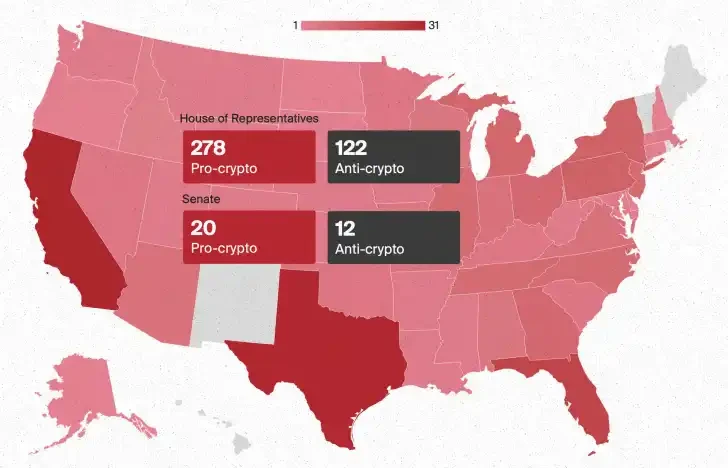
1. Macroeconomic conditions will fundamentally ease, supporting a soft landing
The U.S. yield curve has been inverted for over 24 months, marking one of the longest periods on record. Although the spread between the 2-year and 10-year Treasury yields (2y10y) has recently normalized, the 3-month and 10-year Treasury yield curve (3m10y) remains severely inverted, indicating that market imbalances persist. Bitcoin (BTC) has shown significant sensitivity to these changes; for example, in August 2024, when the 2y10y curve temporarily normalized, Bitcoin's intraday price dropped by $9,000 (-15%). As the short end of the yield curve gradually normalizes, volatility is expected to persist, potentially creating short-term buying opportunities. However, downside risks appear limited due to bullish market sentiment and stabilizing economic conditions, provided that major recession risks can be avoided.
Based on historical patterns and the duration of the 2y10y inversion, the 3m10y curve may normalize by the end of the year, with the Federal Reserve's FOMC meeting on December 18 potentially serving as a major catalyst. This normalization trend aligns with improvements in financial conditions, such as the decline in the National Financial Conditions Index (NFCI), which has retreated from the tight conditions of 2023 to "normal" levels. The reduced use of emergency liquidity tools (such as the Bank Term Funding Program, BTFP) further indicates that conditions are easing. Meanwhile, global net liquidity shows signs of gradual improvement, which is a positive signal for market stability, although current growth levels remain significantly below the peaks of 2021. Ongoing liquidity growth is crucial for maintaining upward momentum in the crypto market, especially as the latter half of the bull market unfolds.
So far, liquidity dynamics have been primarily driven by fiscal measures, while monetary liquidity has lagged. However, a policy shift has emerged post-election, with macroeconomic policy transitioning from demand-side stimulus to supply-side economic strategies. The new policies focus on deregulation, targeted tax cuts, and lowering corporate financing costs, aimed at promoting long-term productivity and job growth. This strategic shift is expected to alleviate inflationary pressures while creating a more stable environment for economic growth. Additionally, increasing U.S. oil production to stabilize reserves and energy costs may reinforce deflationary trends and benefit energy-dependent industries, thereby indirectly supporting broader markets. This will further drive the easing of monetary conditions and interest rates.
The evolving macroeconomic backdrop highlights a transition towards a more sustainable growth model, as supply-side measures replace the top-down demand-driven strategies of recent years. This strategic shift, combined with liquidity improvements and stable financial conditions, positions the crypto market favorably for sustained upward movement. Bitcoin and other major crypto assets are expected to benefit from these favorable conditions, with improvements in macro conditions potentially driving stronger performance and releasing significant growth opportunities in the current bull market cycle.
Global net liquidity is improving but remains significantly below the peaks of 2021.
Impact of Yield Spread and Yield Curve Normalization
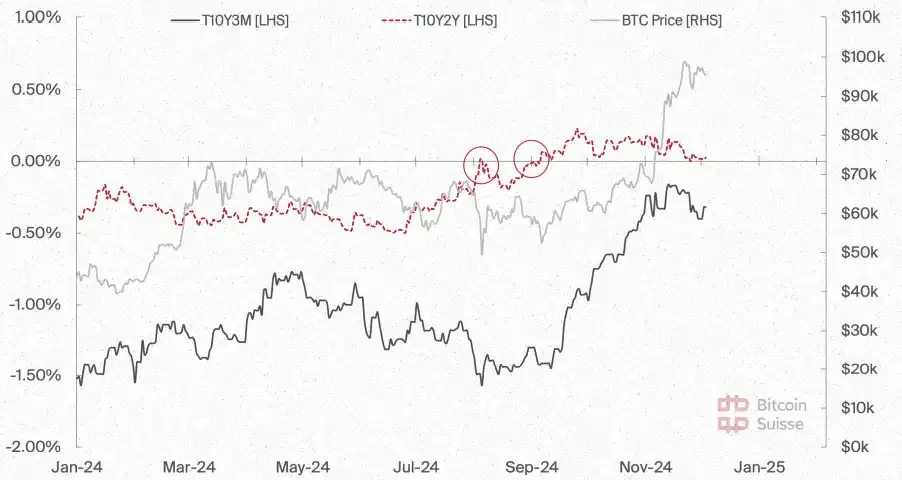
Global Net Liquidity and Global M2 Money Supply

Global net liquidity refers to the total of asset purchases and balance sheet expansions by major central banks worldwide, making it a primary driver of liquidity available in financial markets. Contractions in global net liquidity often coincide with downturns in financial markets, while expansions in liquidity drive overall economic growth and upward trends in asset prices.
2. Bitcoin as a Strategic Reserve Asset for the U.S., with Other Sovereign Nations Following Suit
Bitcoin is at a critical stage of integrating into the core of global reserve strategies. Against the backdrop of increasing fiscal uncertainty, geopolitical divisions, and shifts in monetary order, we predict that Bitcoin will emerge as one of the core assets of national reserves. This trend will change how nations hedge risks and achieve economic sovereignty, enhancing financial resilience through diversified public fund allocations. The record purchases of gold by central banks and the increasingly experimental attempts by sovereign nations to engage with Bitcoin further underscore the growing importance of diversifying reserve assets.
With the incoming Trump administration, we observe a rising momentum for the U.S. to adopt Bitcoin as a strategic reserve asset. The Lummis Bitcoin Act, proposed by Lummis, suggests purchasing 1 million BTC, marking a significant watershed moment that could make the U.S. the largest national holder of Bitcoin, accounting for about 5% of the network's supply. This share, in dollar terms, is comparable to the U.S. share of global gold reserves. The U.S. government currently holds 200,000 Bitcoins through enforcement actions, which could serve as a starting point for a broader reserve strategy and provide precedent support for operations.
Not only is there momentum at the federal level, but state governments are also gradually following suit. For example, Florida and Pennsylvania are actively working to directly purchase Bitcoin for their treasury departments, while Michigan and Wisconsin are opting for a more cautious approach through Bitcoin-related ETFs and trust funds. Additionally, as adoption indicators in both the public and private sectors continue to rise, corporations are adding significant amounts of Bitcoin to their balance sheets, further highlighting Bitcoin's increasingly important role in financial management.
From a global perspective, the influence of Bitcoin as a reserve asset is becoming increasingly evident. Our assessment shows that Bitcoin has surpassed the British pound to become the fifth largest currency in the world, while also ranking as the seventh largest asset globally. These milestones are significant. From a geopolitical standpoint, Bitcoin's neutral characteristics are increasingly favored, as evidenced by Russia and China recently recognizing Bitcoin as property.
As a hedge against potential instability of the U.S. dollar and a force supporting its dominance, Bitcoin is being viewed as a viable solution to current financial challenges. Since 2000, the purchasing power of major fiat currencies has declined by over 70%, reinforcing the demand for a "hard monetary anchor." Additionally, Bitcoin provides a crucial option to address the rising challenges of sovereign debt. The U.S. federal debt has now reached a record $36 trillion, projected to increase to $153 trillion by 2054. Bitcoin's compound annual growth rate (CAGR) could provide the government with a powerful tool to offset the impact of debt growth.
The status of Bitcoin as a reserve asset may not only enhance the fiscal resilience of the United States but also counteract the de-dollarization efforts of hostile nations. Legislative interest and bipartisan support, particularly in the context of evolving monetary conditions, suggest that Bitcoin may soon stand alongside gold as one of the core pillars of strategic reserves.
The impact of Bitcoin achieving reserve asset status is difficult to quantify but could trigger profound changes in the global monetary landscape. Just as gold prices soared in the decade following Nixon's abandonment of the Bretton Woods system in 1971, Bitcoin may experience a similar monetary repricing as it transitions from a controversial fringe asset to a nationally adopted reserve asset. The status of a reserve asset could create a snowball effect, with sovereign nations competing to accumulate holdings, fundamentally altering Bitcoin's market dynamics and potentially breaking the traditional four-year cycle model in the coming years. The key variables are timing and implementation strategies, rather than the certainty of developmental direction.
History of Global Reserve Assets
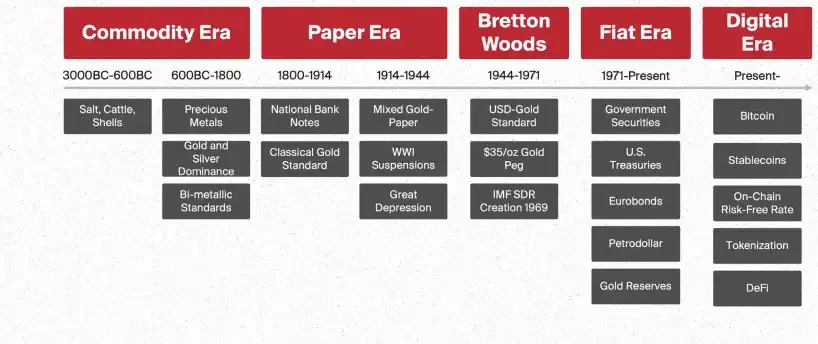
Bitcoin Supply Distribution

"Bitcoin can help solidify the dollar's position as the global reserve currency while serving as a reserve asset to significantly reduce national debt."
— — Senator Cynthia Lummis
3. Bitcoin Price Will Break Through $180,000, Approaching Historical Highs
As we enter 2025, we continue to observe the developments in Bitcoin market dynamics, consistent with our cycle peak forecast first published in November 2023. According to Bitcoin Suisse's Dynamic Cycle Risk and Dynamic On-Chain Cycle Risk models, along with comprehensive growth forecasts, Bitcoin is expected to reach a cycle peak valuation of $180,000 to $200,000 in 2025, creating a historical high.
At the beginning of 2025, Bitcoin's price entered a phase of heightened risk, accompanied by increased dynamic cycle risk. However, from a cyclical perspective, the model does not indicate that this is an ideal time to take profits. Since the beginning of the year, Bitcoin's price has consolidated within the range of $50,000 to $60,000, followed by a significant rise approaching $100,000. Meanwhile, risk indicators suggest that the current price environment is more stable compared to the beginning of the year.
Earlier this year, Bitcoin reached a nominal historical high of approximately $73,000 (the inflation-adjusted price is still over 5% lower than the historical peak of $67,000 in 2021). Although on-chain risks remain at elevated levels, they have not reached a point warranting profit-taking. Notably, long-term holders (LTHs) have shown some selling pressure, but this pressure has been offset by demand from institutional investors, particularly from Bitcoin ETFs. Since their launch, these ETFs have consistently absorbed Bitcoin amounts several times the daily mining output.
Currently, Bitcoin accounts for only 0.2% of global financial assets, far below traditional asset classes such as real estate, bonds, and gold. However, as institutional adoption increases—especially with significant measures that countries like the U.S. may soon undertake—the trajectory of Bitcoin could undergo a major shift, disrupting traditional markets and accelerating its exponential growth. In the context of the current global asset total of $910 trillion, even if Bitcoin captures a 5% to 10% share of these assets, under unchanged conditions and ignoring the significant growth of global assets over time, Bitcoin's price could increase 25 to 50 times, reaching $2.5 million to $5 million per coin.
While this scenario is already quite significant, in the long-term outlook, it may just be a transitional phase. For instance, Michael Saylor predicts that by 2045, Bitcoin's price will reach approximately $13 million per coin. In the short term, such adoption could trigger a "super cycle," pushing Bitcoin's valuation to break through $300,000 in this cycle, aligning with the upper limit of current trend line forecasts.
Bitcoin Suisse's Dynamic Cycle Risk Indicator and Dynamic On-Chain Cycle Risk Indicator
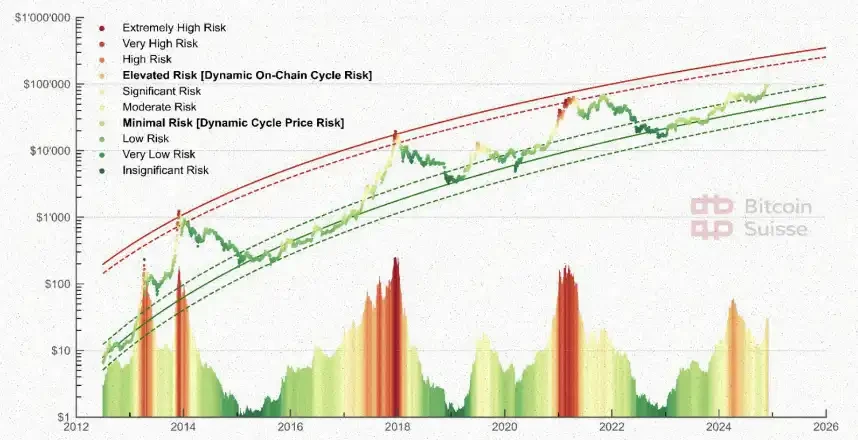
• Price Color Points:
Plotted using Bitcoin Suisse's Bitcoin Dynamic Cycle Risk Indicator to assess the relative risk of Bitcoin price levels.
• Bottom Oscillator:
Constructed based on the Bitcoin Dynamic On-Chain Cycle Risk Indicator to analyze the relative risk level of on-chain activity.
Bitcoin Dynamic Cycle Risk Indicator
The Bitcoin Dynamic Cycle Risk Indicator is a proprietary tool from Bitcoin Suisse used to assess the relative risk of Bitcoin price levels by analyzing key factors such as momentum, trend strength, and inter-cryptocurrency cycle dynamics. This indicator can be adjusted according to market conditions, maintaining stable risk levels during moderate price increases and reducing risk during price stagnation or declines.
The Bitcoin Dynamic On-Chain Cycle Risk Indicator is a proprietary tool from Bitcoin Suisse used to assess the relative risk of Bitcoin on-chain activity by analyzing various individually optimized and adjusted on-chain risk indicators. Each indicator is designed to reflect cross-cycle dynamics and can independently identify market tops and bottoms. This indicator dynamically adapts to market conditions, reducing risk during periods of weakened activity and increasing risk during periods of heightened on-chain activity.
Comparison of Bitcoin and Crypto Assets in Global Financial Asset Market Value

4. Bitcoin's Volatility Will Drop Below That of Major Tech Stocks, Signifying Maturation as an Institutional Asset
Since its inception, one of Bitcoin's defining characteristics has been its significant volatility. However, this volatility has been steadily declining, and we believe that new investment products may further narrow its range of fluctuations. The approval of the first spot Bitcoin ETF, along with the regulatory passage of related listed options, has attracted new capital into the Bitcoin ecosystem, enhanced infrastructure, and expanded the range of investment opportunities. Since late summer, Bitcoin ETFs have accounted for approximately 5%-10% of the average daily trading volume of spot Bitcoin.
The main drivers compressing Bitcoin's volatility include: stable demand flows from institutional adoption, price inertia due to larger market capitalization, systematic portfolio rebalancing flows from asset allocators, complex strategies from hedge funds that weaken extreme volatility, and the overall maturation of the asset class.
Additionally, the options market has played a significant role in this trend. Historically, the options market has proven capable of reducing the volatility of the underlying asset in the medium to long term through a combination of hedging activities and enhanced liquidity.
Professional investors may leverage newly created markets to amplify Bitcoin's inherent volatility. Through strategic trading techniques, they could potentially exacerbate volatility in the short term.
We believe that ongoing regulatory progress surrounding Bitcoin will accelerate its status within mature asset classes. As volatility continues to compress in the future, we expect Bitcoin to further solidify its position as "digital gold" and potentially reach volatility levels below those of high-tech stocks.
The decline in Bitcoin's volatility may enhance its risk-adjusted performance. Over the past year, Bitcoin's high returns have been accompanied by extreme volatility, negatively impacting metrics such as the Sharpe ratio. Since 2017, Bitcoin's absolute return rate has been approximately 7,000%, with a Sharpe ratio of 1.108. In comparison, Tesla's return rate during the same period has been about 2,000%, with a Sharpe ratio of 1.101, while Nvidia's return rate has been 5,600%, with a Sharpe ratio of 1.996.
The decline in Bitcoin's volatility brings a double-edged sword effect: as the asset matures, its stability metrics and institutional applicability improve, while also diminishing the asymmetric return potential historically associated with this asset class.
Bitcoin and Selected Stocks Volatility Forecast
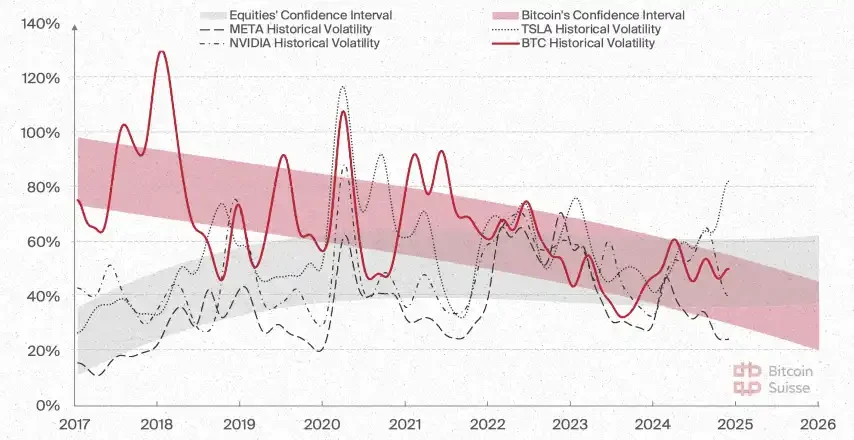
The chart displays the 30-day rolling volatility of four assets: BTC (Bitcoin), Meta, Tesla, and Nvidia. To reduce noise, Gaussian smoothing was applied with a sigma value of 30. The shaded area represents the confidence interval of the average for Bitcoin and selected stocks. To ensure consistency, different quantiles were used for different assets: the confidence interval for Bitcoin is based on the 80th percentile, while the traditional financial stock set uses the 95th percentile. The higher predictability of the traditional financial stock portfolio is attributed to the diversification effect.
5. Financial Giants to Launch Institutional-Level Rollups on Ethereum
Institutions are entering the crypto industry at an unprecedented pace. Stripe completed the largest acquisition ever by acquiring blockchain payment company Bridge; BlackRock has quickly replaced Grayscale as the largest crypto fund by assets under management (AUM). Of the 22 major global financial institutions, 13 have begun exploring the tokenization market, which is expected to reach $16 trillion by 2030. The adoption of Bitcoin ETFs has reached record speeds, and Swift has also launched a pilot project for tokenized fund settlements, with numerous other significant developments in the industry.
We believe the conditions for institutional participation have matured, and their next logical step is to deepen their integration with the Ethereum blockchain through a complete Rollup implementation plan.
Ethereum remains the preferred platform for institutional on-chain use cases (such as stablecoins or tokenization) due to its undisputed high uptime, security, fairness, neutrality, and decentralization. For example, BlackRock has launched its tokenized fund BUIDL, while Visa has announced its tokenized asset platform VTAP, planning to launch a pilot project in 2025.
From a technical structure perspective, the implementation of EIP4844 has achieved widespread success, reducing Rollup transaction costs to less than 1 cent, with daily Rollup transaction volumes increasing to 30 million. Base, Arbitrum, and Optimism are the Rollups with the highest capital inflows in the industry year-to-date, with total value locked (TVL) growing by over 60%. Additionally, significant cross-chain interoperability improvements are expected in the future, enabling these institutions to seamlessly access Ethereum's capital-intensive smart contract ecosystem.
In addition to market expansion, efficiency improvements, and overall first-mover advantages, institutions can also tap into new revenue sources through Sequencing (including MEV and transaction fees). Based on existing Rollup benchmarks, Sequencers can achieve annual revenues of up to $80 million.
Proprietary Rollups can also provide institutions with complete control over latency, consensus rules, token standards, and execution environments, while supporting built-in compliance features such as mandatory KYC or AML checks, blacklist functions, and protocol-level automated regulatory reporting.
Furthermore, the tokenization of ETFs and payment-related opportunities can further supplement Sequencer's revenue sources. Cross-border payments, cost savings, short settlement windows, built-in foreign exchange capabilities achieved through DeFi integration, B2B payments, programmable payment schedules, and real-time fund management operations all provide strong support for Rollups. The packaging of equities and ETFs can also help institutions enter emerging markets, as 90% of the global population still lacks brokerage services. Recent entries into DeFi by institutional funds like BUIDL through Elixir's deUSD protocol indicate that this trend is already quite evident.
Finally, history shows that attempts at private blockchains have failed to materialize, while Rollups on Ethereum represent a natural evolutionary path. This model creates a vertically integrated stack, allowing institutions to control both the infrastructure layer and the financial product layer operating on top of it. The advantages are clear: 2025 will be the inaugural year for institutional Rollups.
RWA Tokenization Across Industries (Excluding Stablecoins)
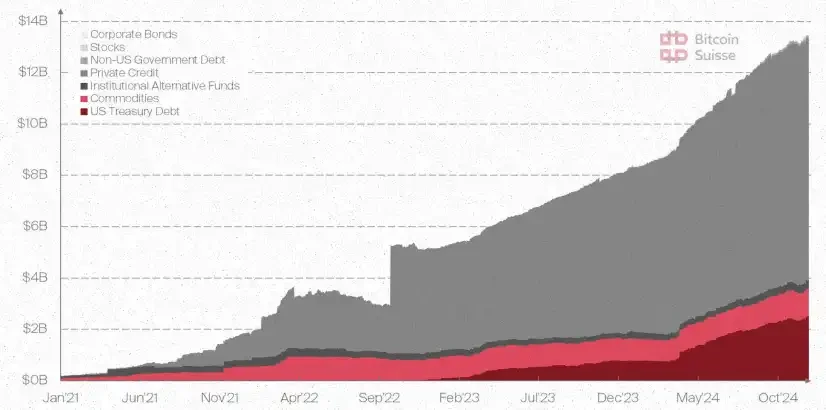
Top Rollup Revenue and On-Chain Profits (Past Year)
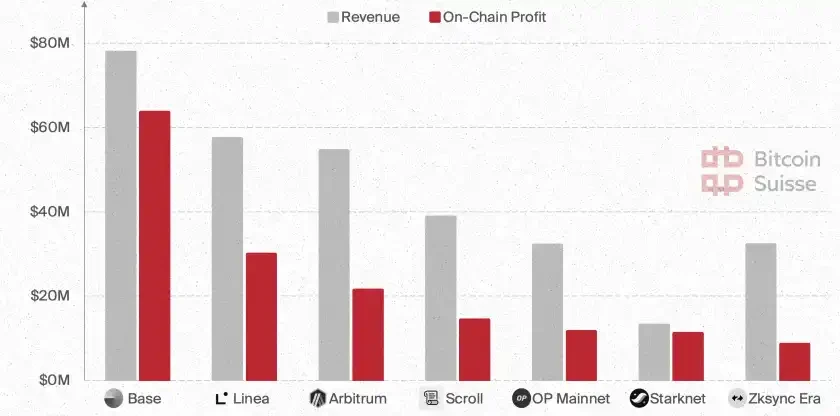
On-chain profits are measured by comparing gas fee revenues with the costs of data and proof submissions on Ethereum, assessing the profitability of Rollups. The improvement in profitability comes from high block space demand (supporting premium pricing) or operators increasing the base fee multiple.
Institutional Adoption of Cryptocurrency
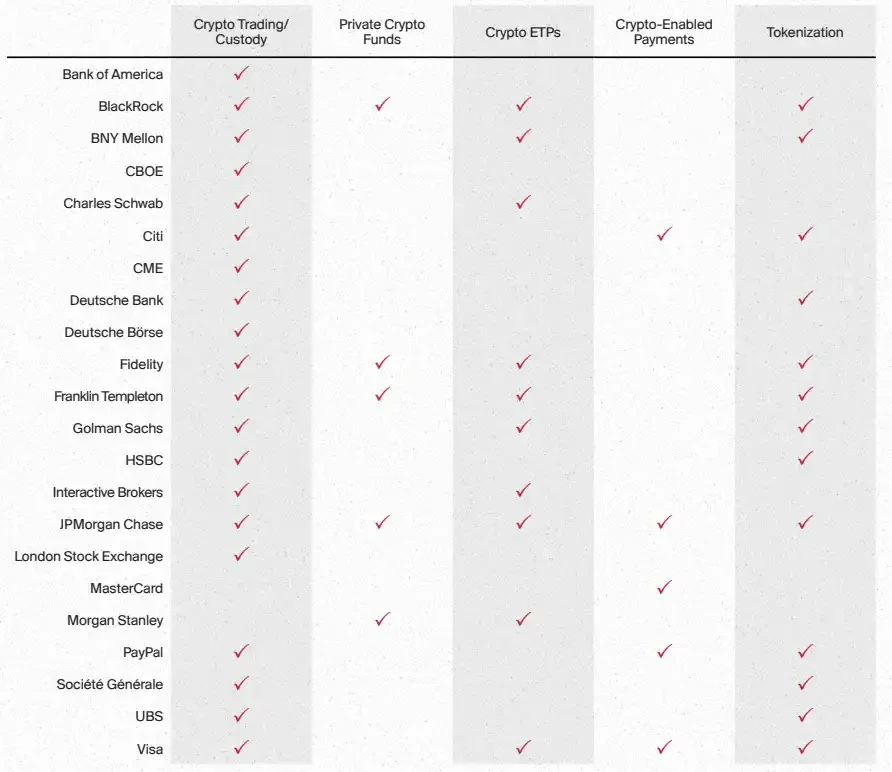
Current conditions are highly favorable for institutional participants to take the next step by fully deploying Rollups on Ethereum, further deepening their blockchain integration.
6. ETH Staking ETFs Will Drive Market-Cap-Adjusted Inflows to Exceed BTC
Despite Bitcoin ETFs achieving a record net inflow of $32 billion and IBIT nearing $50 billion in AUM within just 225 trading days, we anticipate a structural shift in fund flows towards ETH ETFs in the post-election environment. Although ETH has underperformed since the ETF launch, the fundamentals indicate that ETH is increasingly presenting an attractive risk-return profile amid a surge in institutional participation. November marks a turning point for ETH ETF capital inflows, achieving net inflows for the first time since its July launch, with a single-day inflow reaching $332.9 million, surpassing Bitcoin's $320 million. Additionally, recent inflows have caught up with Bitcoin on a market-cap-adjusted basis.
We believe that ETH's relative underperformance since its ETF approval primarily reflects institutions' initial preference for Bitcoin's mature narrative and higher awareness, while also being impacted by regulatory hurdles surrounding ETH ETF staking yields. Regulatory uncertainty and opportunity costs due to the inability to earn staking rewards have significantly limited institutional capital inflows. However, this gap lays the groundwork for strong rebound potential once the bottleneck is removed. We expect that under a new Trump administration, ETH staking ETFs will be rapidly approved, unlocking yields of 3%-4%. This feature caters to the needs of institutional allocators and is particularly attractive in a declining interest rate environment. We predict that staking yields will significantly benefit Ethereum and become a major catalyst for sustained capital inflows into ETH ETFs. Furthermore, strategic acquisitions by staking service providers (such as Bitwise) further indicate that these participants are actively preparing for this outcome.
In addition to ETH staking ETFs, we expect more cryptocurrency ETFs to be approved in 2025, including SOL and XRP, which may spark broader discussions about L1 classification as commodities. However, ETH's unique position—as a regulated, yield-generating asset with a proven institutional adoption rate—may remain unchallenged. Compared to Bitcoin, ETH is currently in the early stages of its institutional adoption lifecycle. With institutional capital limited to rotation between the two major crypto assets, ETH's supply dynamics strongly suggest its potential for future value appreciation. Over the past 12 months, more than 70% of ETH supply has remained inactive, while staking participation rates have reached an all-time high.
In summary, we predict that a new wave of institutional crypto allocation driven by yields will emerge post-election, reversing fund flows. The favorable intersection of regulatory tailwinds, yield potential, and supply dynamics will enable ETH ETFs to surpass BTC in market-cap-adjusted inflows in 2025.
Performance Since the Launch of ETH ETF

Cumulative Net Inflows and Daily Fund Flows for ETH ETF
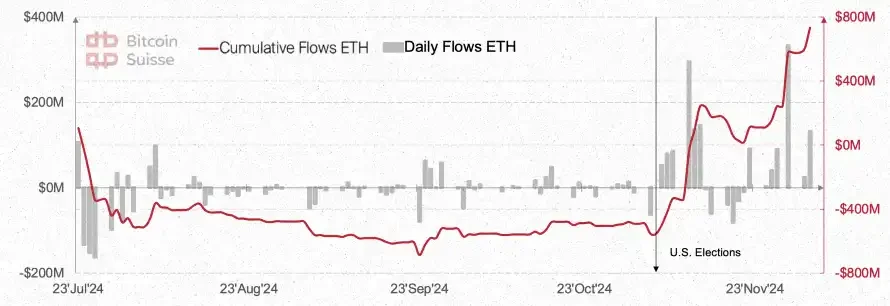
Market-Cap-Adjusted Fund Flows for ETH and BTC ETFs

7. Bitcoin's Dominance Expected to Peak by Year-End
Bitcoin's market dominance is expected to reach a peak in this cycle at a turning point in 2025, marking a significant change in the structure of the crypto market. While Bitcoin's absolute value will continue to grow, its dominance is likely to decline in the final stages of the bull market as capital shifts towards investing in other crypto assets (i.e., Altcoins). This pattern aligns with the Bitcoin halving-driven market cycle: Bitcoin's dominance typically surges in the early stages but begins to decline as the bull market enters its final phase, with Altcoins starting to take the lead.
Ethereum (ETH) and Solana (SOL) are key assets expected to outperform Bitcoin in BTC trading pairs during this phase. Unlike most Altcoins, many of which see their dollar valuations relatively stable while their ratios to Bitcoin trend towards zero over time, ETH and SOL behave like oscillators, maintaining resilience in their relative strength against Bitcoin. This resilience reflects their increasing importance within the broader crypto ecosystem, providing investors with a more diversified growth trajectory than Bitcoin.
The anticipated decline in BTC dominance aligns with historical trends and broader macroeconomic dynamics, including liquidity cycles, halving processes, and the typical slowdown in market sentiment following halvings and elections. As liquidity improves, the appeal of investing in high-risk assets increases, amplifying the trend of capital shifting towards Altcoins, which is expected to yield excess returns. This structural shift highlights the role of Altcoins in the later stages of the cycle, with their relative returns expected to surpass those of Bitcoin.
While Bitcoin will still deliver strong returns, the major gains in the later stages of the bull market are expected to come from Altcoins. This situation reflects a gradually maturing market structure where capital is more inclined towards high-risk opportunities during bullish sentiment. As Bitcoin's dominance declines, Altcoins will capture a larger market share, prompting investors to reassess their portfolio strategies in the final stages of the bull market. After this phase, Bitcoin's dominance is expected to rebound, laying the groundwork for the next market cycle.
Trend of Bitcoin Dominance
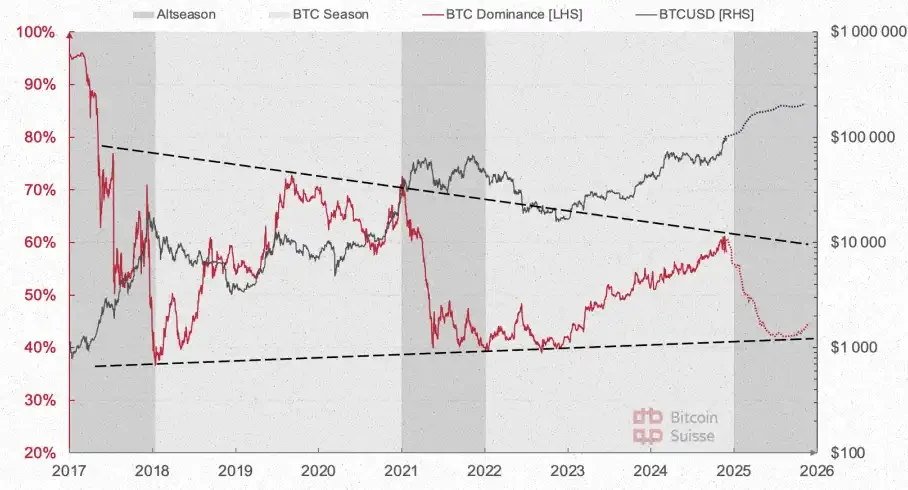
Periodic Fluctuations of Ethereum (ETH) and Solana (SOL) Compared to Bitcoin (BTC)
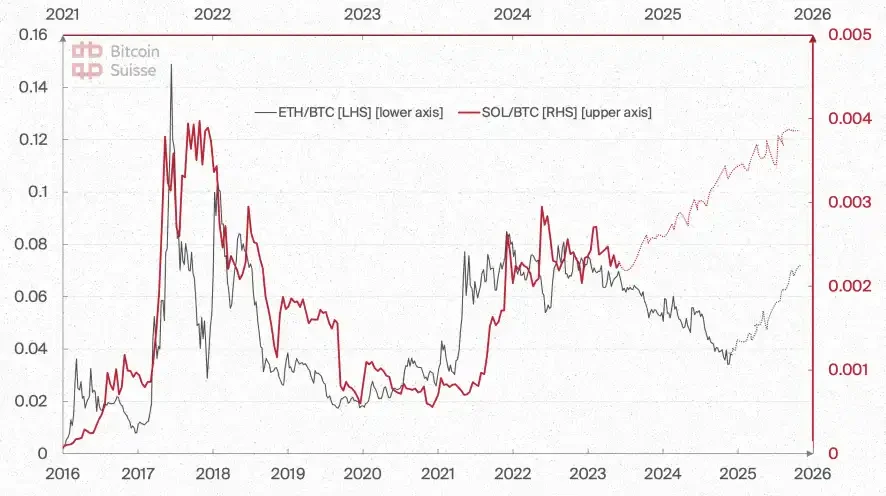
8. ETH's Monetary Policy Anchor Accelerates Its Monetization Process
Despite strong support for modifying ETH's monetary policy, the issuance rate of Ethereum staking rewards will not change in 2025, nor will there be consensus to include modifications in the anticipated hard fork in 2026. During 2024, several Ethereum researchers raised concerns about the sustainability of staking economics and proposed adopting a new issuance curve, setting a cap on staking ratios, or implementing mechanisms to stabilize them around target values. These proposals aim to address risks associated with excessively high staking ratios, including unnecessary inflation and pressure on the network. In extreme cases, ETH could be replaced by a single dominant liquid staking token (LST), which would have unacceptable effects on Ethereum.
We believe it is crucial for ETH to maintain its role as a trusted neutral currency in global settlements, hence the concern over excessively high staking ratios. However, there are also opposing voices advocating for monetization goals, arguing that any adjustments to issuance could undermine its perception as "sound money" (especially in comparison to Bitcoin's fixed monetary policy).
Although ETH's issuance policy has changed multiple times, the most notable example being the introduction of staking, the rise of competitors like Celestia and Solana in 2024 makes it increasingly important to maintain ETH's monetary attributes. While competitors can quickly optimize specific areas, the process of having their new tokens accepted as currency is much more challenging.
Due to the significance of this decision and the divergence on how to achieve monetization, it is expected that the Ethereum community will struggle to reach consensus on changing the issuance policy before the end of 2025. Furthermore, we believe that even if ETH staking ETFs are approved, its staking ratio will not reach the levels exhibited by most PoS chains. We anticipate that the staking ratio will increase at a similar growth rate as last year (+18%), reaching approximately 33% by 2025. The relatively low staking ratio and the integration of validators following the implementation of EIP-7251 will further reduce the urgency for policy changes.
We believe that the consolidation of ETH's monetary policy in 2025 will positively impact its valuation while differentiating it from other platforms. However, we do not rule out the possibility of adjustments in the future after achieving a broader social consensus, thereby defining the "final form" of staking economics.
Example: Proposed Changes to Issuance Curve and Issuance Yield
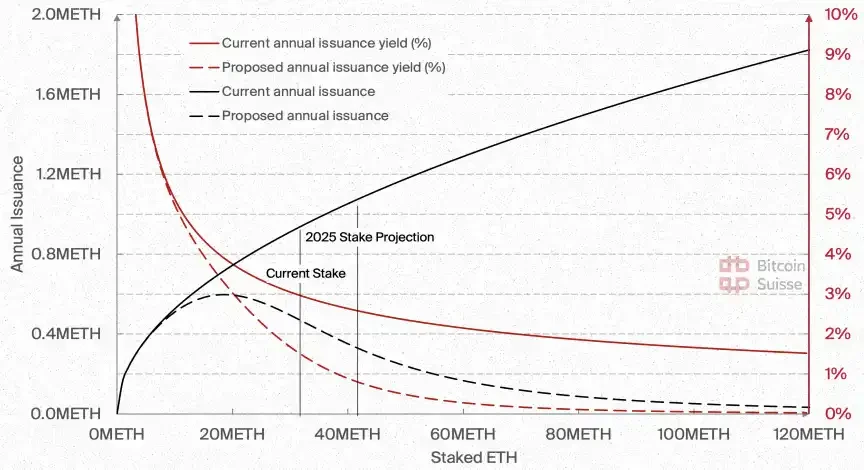
Issuance yield is lower than staking yield because it does not include transaction fees and MEV.
Changes in Total Supply and Staking Ratio of ETH

Comparison of Staking Ratios of Major PoS Networks
9. Altcoin Season Expected to Peak in the First Half of 2025, Total Market Cap Projected to Grow Fivefold
As the crypto market enters a critical phase in 2025, the Altcoin season is on the horizon. Historically, this transition typically occurs in the later stages of a Bitcoin-dominated bear market, during which Altcoins consistently underperform (indicated by the dark gray area in the chart). However, the upcoming market rotation will drive capital (primarily from Bitcoin) towards Altcoins, marking the beginning of a decisive and significant Altcoin season.
The most explosive Altcoin seasons usually coincide with the final sprint of a Bitcoin bull market, often occurring when Bitcoin reaches its cyclical peak. This cycle appears to be no exception. Bitcoin's market cap is expected to approach $4 trillion, with its dominance declining, creating ideal conditions for Altcoins to outperform. Current trends suggest that the first half of 2025 will witness the strongest and most significant Altcoin season of this cycle, driven by capital rotation and a high-risk appetite, particularly evident as Bitcoin consolidates near its peak.
Using Bitcoin and Ethereum's market cap targets as benchmarks, the potential scale of Altcoin performance becomes clear. Assuming the total crypto market cap for this cycle reaches approximately $15 trillion, with Bitcoin's expected market cap at $4 trillion and Ethereum's at $1 to $1.5 trillion, this leaves about $10 trillion for Altcoin allocation. Currently, TOTAL3 (the total market cap of Altcoins excluding Bitcoin and Ethereum) stands at only $1 trillion, indicating that as the cycle matures, the Altcoin market overall may have up to tenfold growth potential.
The peak of Bitcoin's market cap, the expansion of Ethereum, and the expectation of capital flowing into Altcoins collectively form the basis for a deep Altcoin season in the first half of 2025. This period will provide significant opportunities for excess returns, with some assets expected to achieve exponential growth. As market dominance shifts, actively positioning and diversifying into Altcoins will be key to capturing the full potential of this high-growth phase.
Altcoin Season Index: Indicating a Significant Increase in Recent Altcoin Returns
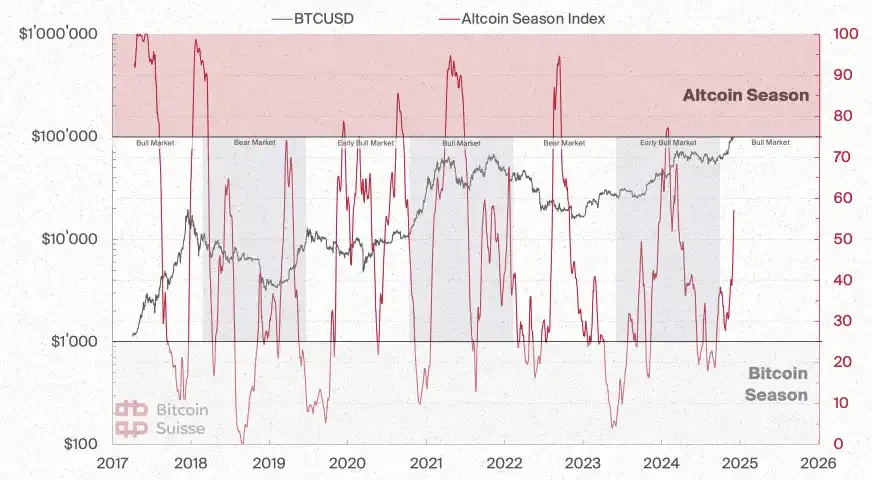
Altcoin Season Index: Measures whether the top 50 crypto assets (excluding stablecoins) outperform Bitcoin over a set period. When the index value exceeds 75, it indicates the onset of an Altcoin season; below 25 indicates Bitcoin's dominance.
TOTAL3: The total crypto market cap excluding Bitcoin and Ethereum, essentially representing the market cap of all Altcoins.
Market Cap Predictions for Bitcoin, Ethereum, and Altcoins: Indicating Multiple Growth in the Future

10. Solana Consolidates Its Market Position as a Top General-Purpose Smart Contract Platform
In 2024, Solana emerged as a strong competitor to Ethereum in terms of Real Economic Value (REV: transaction fees + MEV tips) and recognition from founders, investors, and users. We expect Solana to continue to maintain its advantage in a competitive environment in 2025 as foundational improvements progress.
With rapid iteration cycles, a strong core developer team, and consistency in value propositions and optimization strategies, Solana is currently well-positioned to enhance its network effects. However, it will face fierce competition next year from Ethereum and other existing platforms (such as Aptos and Sui) as well as emerging platforms (such as Monad and MegaETH). High throughput and low fees may no longer be significant differentiators, so key improvements must be made at the foundational level while "increasing bandwidth and reducing latency."
The most anticipated upgrade in 2025 is the maturation of Firedancer, which will make Solana a more robust multi-client network. The Firedancer codebase will operate independently of Agave, significantly reducing the risk of chain client failures, allowing validators to easily switch clients without waiting for issues to be resolved. Firedancer has been running on the mainnet in a non-voting mode, enabling the team to collect data and test new features and optimizations.
Other foundational improvements will focus on several key areas:
• Mitigating state growth: Addressing state growth through increased application of state compression techniques.
• Handling state contention: Improving state contention issues through the global adoption of a central transaction scheduler.
• Development of zk-rollups: Expecting more zk-rollups to emerge based on recently introduced dedicated system calls.
• Improvements in token economics: Reallocating priority fees to stakers (SIMD-0123) and continuing discussions on reducing issuance.
• Enhanced scalability: Improving scalability through asynchronous execution techniques and advancements in hardware capabilities.
• Strengthened censorship resistance: Enhancing censorship resistance through the implementation of a multi-parallel leader mechanism.
• Development of lightweight full node clients: Continuing to advance the Mithril project to reduce hardware requirements.
While we do not expect all these improvements to be realized in 2025, the shift from "rapid iteration and rebuilding" to a greater focus on strategic foundational improvements by independent teams gives us confidence in Solana's sustainable success as a top general-purpose smart contract platform. This success will be reflected in Solana continuing to be the preferred platform for DeFi and DePIN founders and becoming more attractive to institutional-grade token issuers, which is crucial for realizing the potential of a global, permissionless, efficient state machine.
Monthly Real Economic Value of Solana and Ethereum
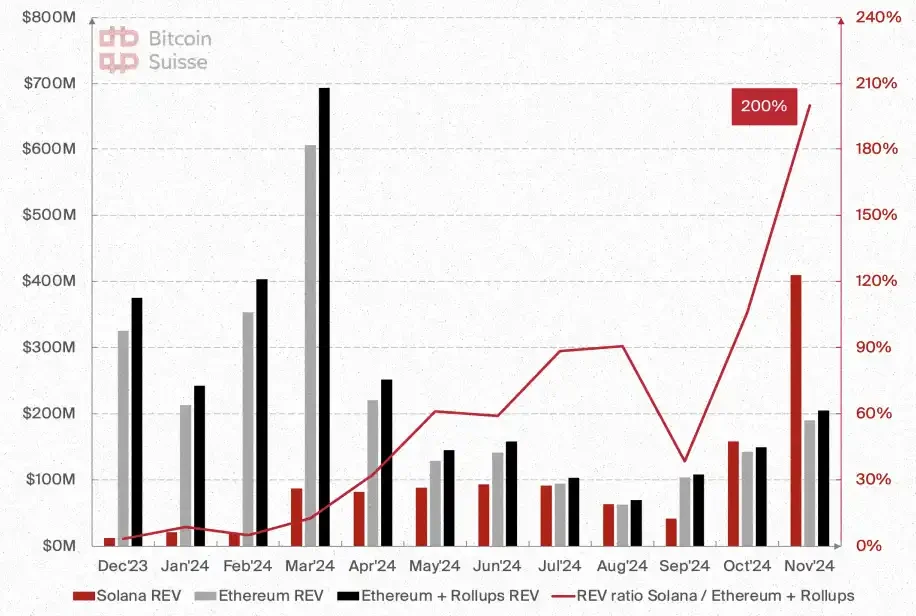
11. Wealth Effect Expected to Drive NFT Momentum in the Later Stages of This Cycle
In recent years, the NFT market has experienced a deep correction, with a gap between market expectations and reality. We anticipate that this trend will reverse in the later stages of this cycle, primarily driven by the wealth effect across the industry and capital rotation. Although the performance of most NFT collectibles may remain sluggish, we believe that top collectibles (such as CryptoPunks or Fidenzas) will solidify their status as social identifiers in the crypto space and high-end digital art, especially generative art. Supported by blockchain technology, generative art has found an ideal performance platform, demonstrating the value of persistent, non-fungible, and ownable digital content through verifiable scarcity and on-chain provenance.
Projects like Pudgy Penguins have recently gained more attention, ranking as the second-largest NFT project by market cap, buoyed by expectations surrounding the upcoming launch of its PENGU ecosystem token. In the current trend of cryptocurrency culture, which clearly favors MemeCoins, the meme potential of PENGU may surprise the market. Additionally, as the most successful consumer brand in the crypto space, the launch of the Abstract chain by its parent company may further accelerate its momentum.
The increase in trading volume in November and the recent performance of collectibles seem to indicate early signs of this trend. Magic Eden has become the first major NFT platform to complete a valuation event, while OpenSea may also be brewing a similar event. These events could enhance the stickiness and liquidity of the NFT market. Driven by these catalysts, we expect the value of related NFT collectibles to appreciate significantly. As observed in the previous cycle, NFTs typically lag in performance before market euphoria peaks, so late-stage wealth effects may once again trigger a new wave of demand for highly scarce collectibles.
We predict that early Artblocks collectibles will be natural beneficiaries of this momentum. These collectibles combine historically significant on-chain generative art, recognition from renowned artists, verified collector demand, and true scarcity. Furthermore, these collectibles maintained a relatively high price floor during the bear market and are expected to benefit in the next phase of market maturation, especially those representing key moments in digital art history.
With the rise of a younger generation more familiar with digital technology, this trend may be further amplified in future cycles.
Historical Performance of CryptoPunks (in ETH and USD)
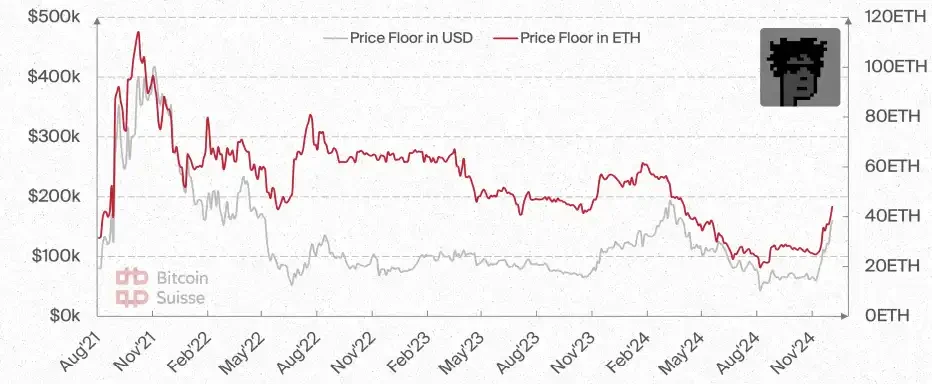
Historical Performance of Fidenzas (in ETH and USD)
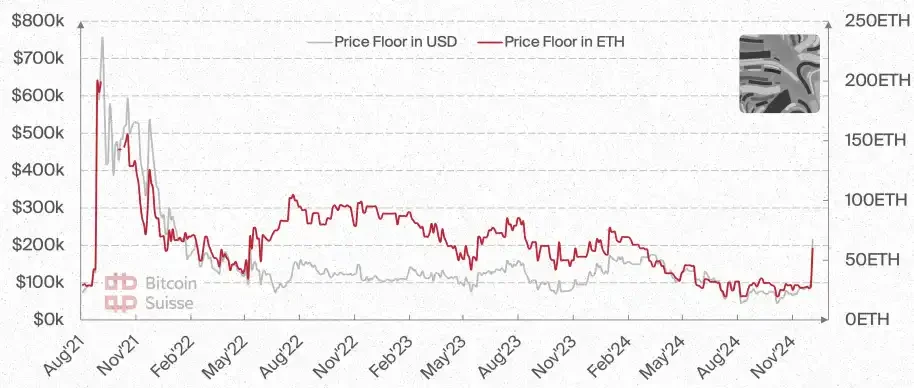
免责声明:本文章仅代表作者个人观点,不代表本平台的立场和观点。本文章仅供信息分享,不构成对任何人的任何投资建议。用户与作者之间的任何争议,与本平台无关。如网页中刊载的文章或图片涉及侵权,请提供相关的权利证明和身份证明发送邮件到support@aicoin.com,本平台相关工作人员将会进行核查。




